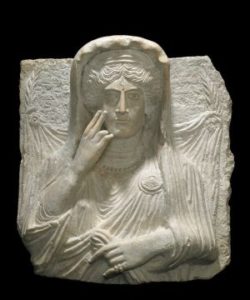
An exquisitely sculpted ancient bust of a woman from Palmyra, Syria, is returned to view for the first time since 2006 at the Smithsonian’s Freer Gallery of Art and Arthur M. Sackler Gallery. Named “Haliphat,” it will be accompanied by images of 18th-century engravings and 19th-century photographs of ancient Palmyra selected from the Freer|Sackler Libraries and Archives. A newly created 3-D scan of the bust will also be released for viewing and download at a later date as part of the Smithsonian X 3D Collection.
Palmyra, a UNESCO World Heritage site, is one of the most important archaeological sites in the Near East, and one of the best preserved city-states in the world.
“In the face of current tragic upheavals in Iraq and Syria, every stone, arch and carved relief plays a greater historical and cultural role than it has in the past,” said Julian Raby, the Dame Jillian Sackler Director of the Arthur M. Sackler Gallery and Freer Gallery of Art. “Like the relief of Haliphat, each stone can remind a people of its past, and fashion identity both individually and collectively.”
Once lush, wealthy and cosmopolitan, Palmyra (“the city of palms”) was an oasis in the desert at the hub of trade between the Mediterranean, Mesopotamia, ancient Iran and Southeast Asia. Two millennia ago, its inhabitants constructed monumental colonnades, temples, a theater and elaborate tomb complexes, a significant amount of which survives today.
Dating from 231 AD, the limestone funerary relief sculpture depicts an elegant, bejeweled figure with both Roman and Aramaic artistic influences, reinforcing Palmyra’s status between the Eastern and Western worlds.
The accompanying photographs were taken 1867-1876 by prolific photographer Fèlix Bonfils and provide the most complete visual record of Palmyra from the 19th century.
_____________________________________
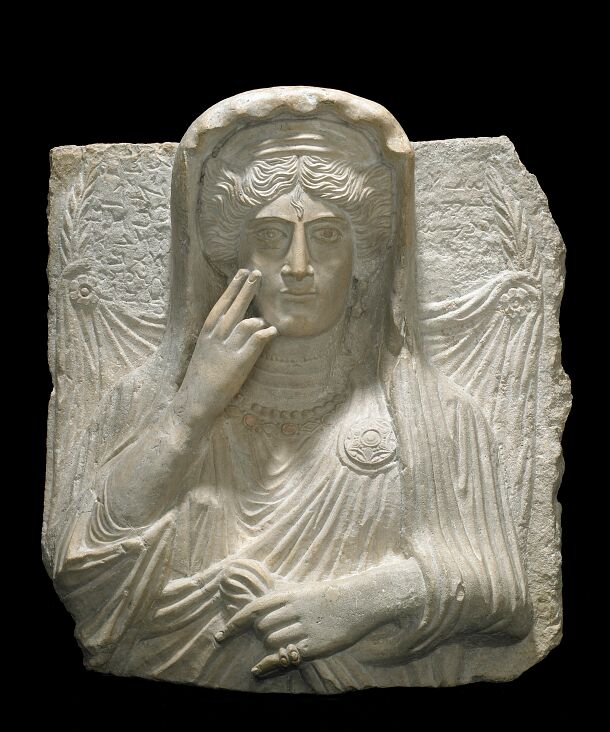 The funerary bust of Haliphat, from Palmyra, 231 BC. Courtesy Freer/Sackler galleries
The funerary bust of Haliphat, from Palmyra, 231 BC. Courtesy Freer/Sackler galleries
____________________________________
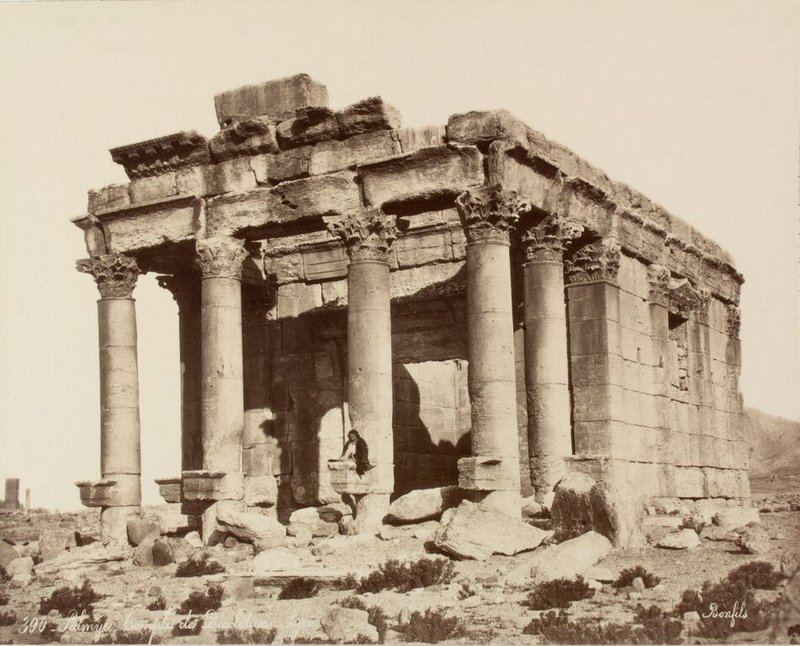 Above and below: Two examples of 19th century photographs on display at the exhibit. Courtesy Freer/Sackler galleries
Above and below: Two examples of 19th century photographs on display at the exhibit. Courtesy Freer/Sackler galleries
__________________________________________________
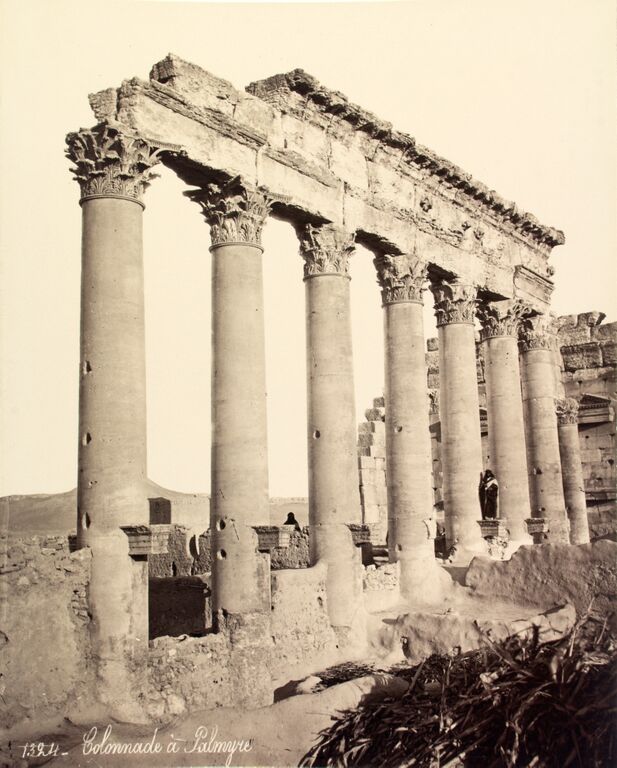 ______________________________________________________
______________________________________________________
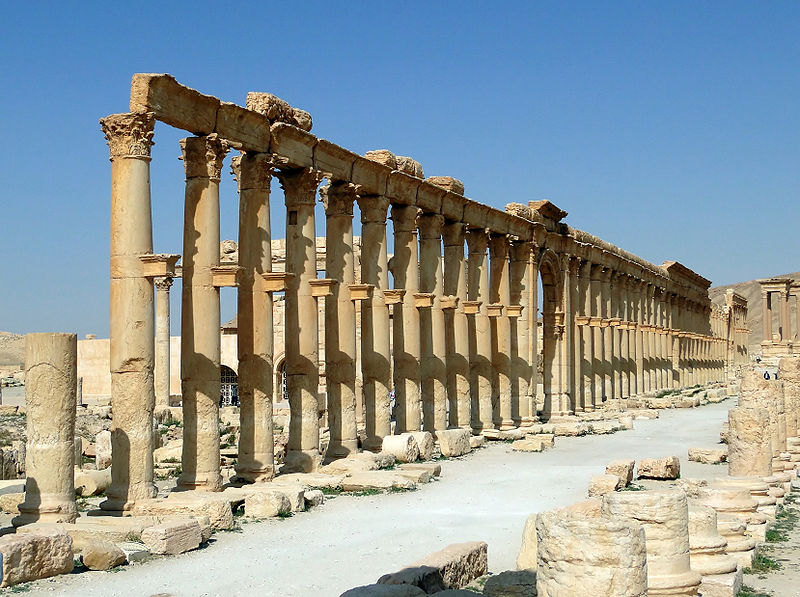 Palmyra as it appears today. ISIS has already destroyed some of the antiquities at this iconic site. Bernard Gagnon, Wikimedia Commons
Palmyra as it appears today. ISIS has already destroyed some of the antiquities at this iconic site. Bernard Gagnon, Wikimedia Commons
_________________________________________________
The engraving images are from Robert Woods’ 1753 The Ruins of Palmyra, a publication that inspired the popular neoclassical architecture style in Britain and North America. Its image of an “Eagle Decorating an Ancient Roman Temple” was the model for the image on the seal of the United States, and its depictions of Palmyra’s coffered ceilings shaped the ceiling of the north entrance of the Freer Gallery of Art.
The display will be on view indefinitely.
__________________________________________________
A press release of the Freer/Sackler galleries of art
The Freer Gallery of Art, which opened in 1923, and the adjacent Arthur M. Sackler Gallery, founded 1987, are the Smithsonian’s museums of Asian art and together contain one of the world’s most important collections of Asian and American art. The galleries are located on the National Mall in Washington, D.C. Admission is free. For more information, visit www.asia.si.edu.
__________________________________________________
 Read more in-depth articles about archaeology with a premium subscription to Popular Archaeology Magazine.
Read more in-depth articles about archaeology with a premium subscription to Popular Archaeology Magazine.
In addition, the latest Popular Archaeology ebook is now available.
______________________________________________
Travel and learn with Far Horizons.
____________________________________________
 Popular Archaeology’s annual Discovery Edition eBook is a selection of the best stories published in Popular Archaeology Magazine in past issues, with an emphasis on some of the most significant, groundbreaking, or fascinating discoveries in the fields of archaeology and paleoanthropology and related fields. At least some of the articles have been updated or revised specifically for the Discovery edition. We can confidently say that there is no other single issue of an archaeology-related magazine, paper print or online, that contains as much major feature article content as this one. The latest issue, volume 2, has just been released. Go to the Discovery edition page for more information.
Popular Archaeology’s annual Discovery Edition eBook is a selection of the best stories published in Popular Archaeology Magazine in past issues, with an emphasis on some of the most significant, groundbreaking, or fascinating discoveries in the fields of archaeology and paleoanthropology and related fields. At least some of the articles have been updated or revised specifically for the Discovery edition. We can confidently say that there is no other single issue of an archaeology-related magazine, paper print or online, that contains as much major feature article content as this one. The latest issue, volume 2, has just been released. Go to the Discovery edition page for more information.
____________________________________________







